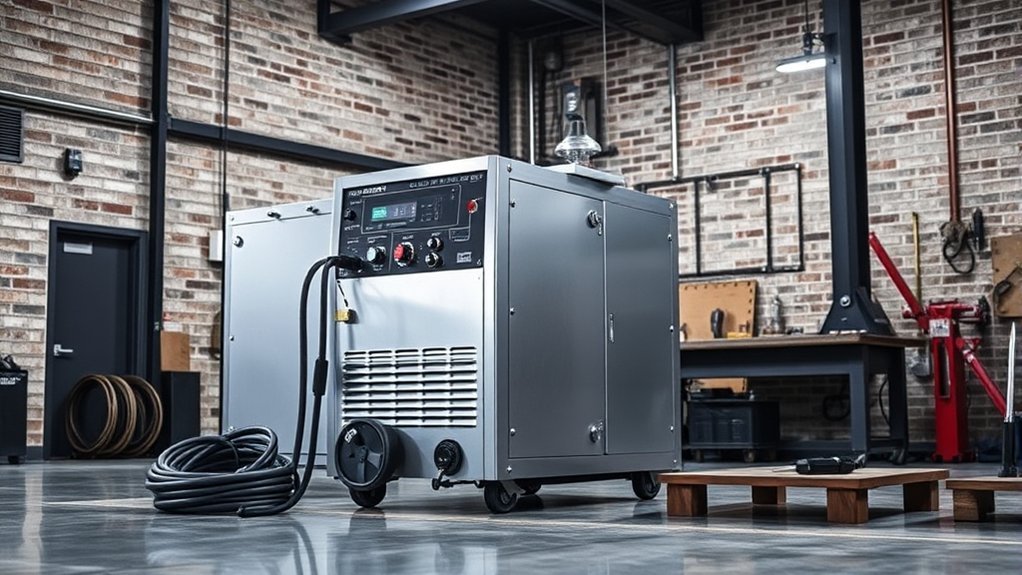Welding machine costs can vary widely depending on the type you choose. Basic stick welders start around $100, while MIG welders range from $300 to $1,000. TIG welders typically begin at $500 and can exceed $5,000 for advanced features. For versatility, multiprocess machines can cost from $1,000 to over $10,000. Remember to factor in ongoing expenses like consumables and safety gear when budgeting for your welding setup. There’s plenty more to explore about equipment choices and costs.
Overview of Welding Equipment Types
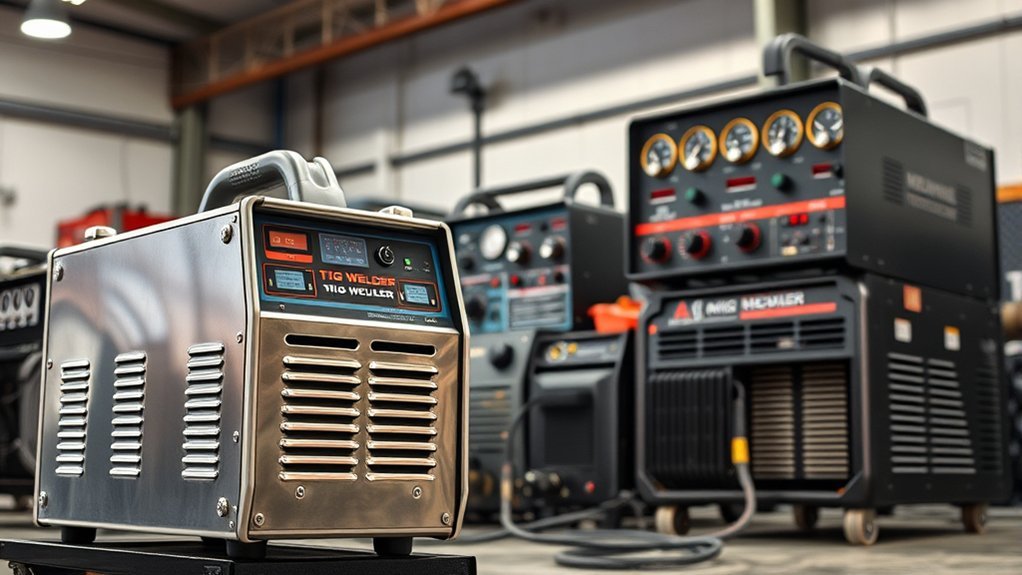
When you immerse yourself in the world of welding, understanding the different types of welding machines is essential for selecting the right equipment for your projects.
MIG welders are favored for their simplicity and versatility, making them ideal for beginners and professionals alike. TIG welders excel in precision for intricate jobs but typically come at a higher price point. Stick welders are the most affordable option, perfect for outdoor and heavy-duty work on thick materials.
MIG welders offer unmatched simplicity, while TIG welders provide precision; Stick welders are budget-friendly for heavy-duty tasks.
If you need versatility, multiprocess welders can handle various welding techniques, accommodating MIG, TIG, and Stick processes.
Consider machine portability as well; some models are designed for easy transport, allowing you to work in multiple locations without hassle, enhancing your overall efficiency.
Cost Breakdown and Comparison of Different Types of Welders
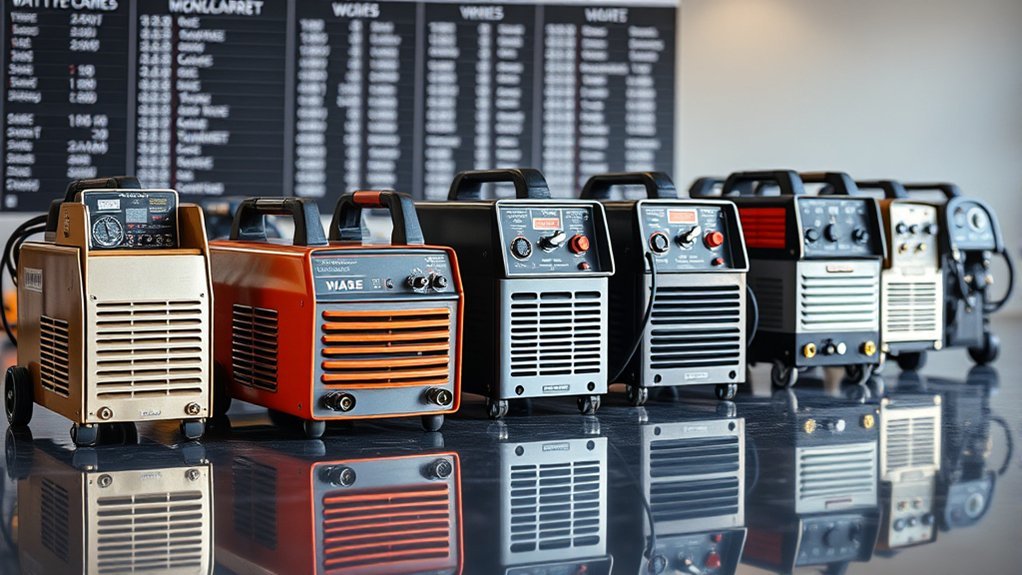
Understanding the cost of various welding machines is essential for making an informed purchase decision.
MIG welders typically range from $300 to $1,000, with entry-level models around $300, while industrial-grade options exceed $1,000.
TIG welders start at $500 and can exceed $5,000 due to advanced features.
Stick welders offer the most affordable option, starting at approximately $100, suitable for beginners.
Multiprocess welders, versatile enough for MIG, TIG, Stick, and Plasma welding, generally range from $1,000 to over $10,000 for professional setups.
When considering welding machine brands, evaluate the capabilities and durability that suit your needs, especially if you’re looking for beginner welder options or advanced functionalities in your projects.
Factors Affecting Welding Equipment Costs
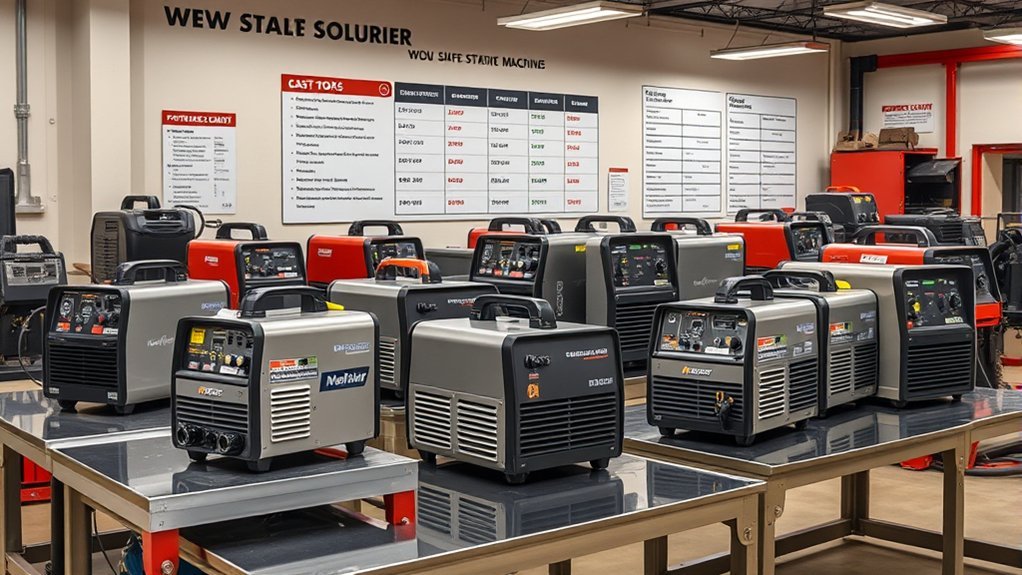
When considering the cost of welding equipment, several key factors come into play.
The power output of the machine directly affects its price, with higher wattage models generally costing more due to their enhanced capabilities.
Additionally, features like advanced technology and brand reputation can greatly influence what you’ll pay, along with the long-term maintenance and operation costs that come with your choice.
Power Output Influence
The power output of welding machines greatly influences their cost, as higher-capacity models offer enhanced performance and versatility. Generally, there’s a direct cost correlation between power output and price.
For example, MIG welders with lower power outputs can start around $300, while industrial-grade models may exceed $1,000. TIG welders, known for precision, often range from $500 to over $5,000, with higher outputs justifying the increased price.
Stick welders typically cost between $100 and $1,000, with powerful versions approaching the higher end. Multiprocess welders, which can perform MIG, TIG, and Stick welding, often feature higher power outputs and can range from $1,000 to over $10,000, reflecting their capabilities and versatility in various applications.
Additional Features Impact
While many factors contribute to the cost of welding machines, additional features play a pivotal role in determining their price. Digital controls enhance precision and ease of use, often resulting in higher costs due to their advanced functionality.
Automation benefits, such as decreased labor requirements and improved consistency, can also greatly raise the price of welding equipment. Additionally, energy-efficient models tend to be more expensive upfront but can yield long-term savings, making them a smart investment.
Finally, brand reputation influences pricing; established brands often charge more due to perceived reliability. When considering your options, weigh these additional features carefully against your budget and operational needs to guarantee you’re making a sound investment.
Maintenance and Operation Costs
Understanding maintenance and operation costs is essential for anyone investing in welding equipment, as these expenses can greatly impact your overall budget.
The power output of your welding machine plays a significant role; higher outputs often lead to increased costs. Energy-efficient models may have a higher initial price but can reduce operational expenses over time.
Additionally, advanced features like digital controls can add to your costs. Maintenance complexity and the necessity of skilled operators underscore the importance of proper operator training to mitigate high maintenance fees.
Finally, don’t forget to take into account long-term expenses, including consumables and routine maintenance, when evaluating the initial purchase price of your welding equipment based on the welding techniques you’ll employ.
Ongoing Costs and Considerations When Purchasing Welding Equipment
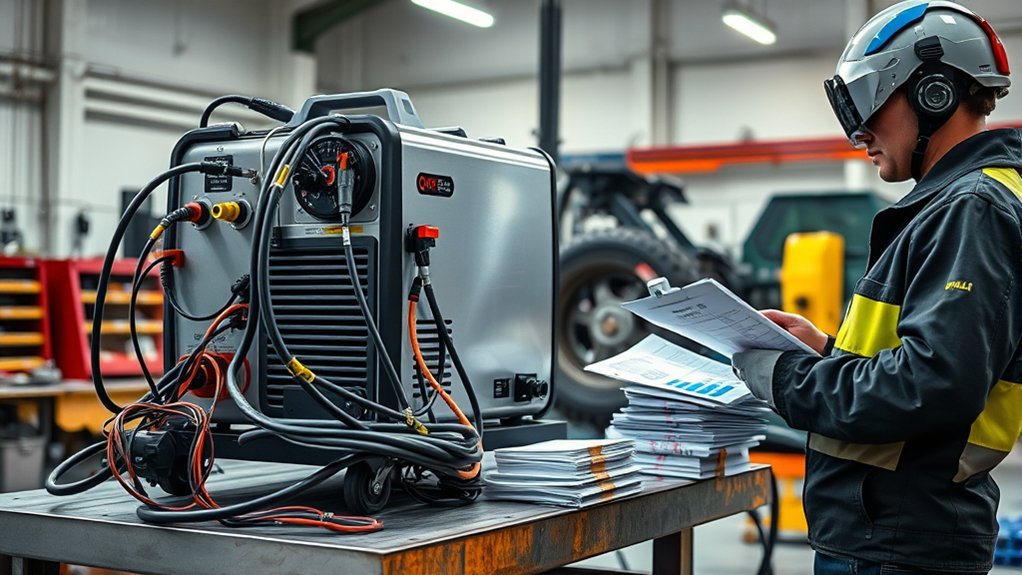
When you evaluate the initial investment in welding equipment, it’s essential to factor in long-term maintenance expenses that can accumulate over time.
Choosing high-quality brands can reduce these costs by minimizing repairs and enhancing durability.
Additionally, considering the costs of safety gear and operator training will guarantee you’re prepared for both immediate and future welding needs.
Initial Investment Evaluation
Evaluating the initial investment for welding equipment involves more than just the sticker price; it requires a thorough look at ongoing costs and considerations. Different welding machine types come with varying initial costs, from basic Stick welders at around $100 to advanced Multiprocess welders exceeding $10,000.
| Cost Factor | Description | Estimated Cost |
|---|---|---|
| Purchase Price | Initial cost of the machine | $100 – $10,000 |
| Consumables | Electrodes, filler materials | Varies by project |
| Safety Gear | Helmets, gloves, protective gear | $200 – $500 |
Investing in quality brands and training operators can reduce long-term expenses, making thoughtful investment strategies essential for your budget.
Long-term Maintenance Expenses
While considering the long-term maintenance expenses of welding equipment, you’ll find that these costs can vary widely based on the type and complexity of the welder you choose. Basic models often have lower ongoing expenses, while advanced multiprocess machines might require more frequent servicing.
Regular maintenance, like cleaning and replacing consumables, is essential for maximizing your welding equipment lifespan and minimizing costs. Investing in reputable brands can lead to better reliability and fewer breakdowns, ultimately saving you money.
Additionally, proper maintenance training benefits your operators by preventing misuse and reducing long-term repair costs. Don’t forget to account for consumables like welding rods and gas, as these ongoing expenses can greatly impact your budget over time.
Popular Welding Machines

Many welders rely on a select few machines that stand out for their performance and features. The Miller Millermatic 211 PRO MIG Welder is favored for its reliability and ease of use, typically priced between $300 and $1,000. If you’re looking for versatility, the Razorweld 160di Multi-Process Welder is an excellent entry-level choice. Below is a comparison of some popular options:
| Machine | Price | Key Features |
|---|---|---|
| Miller Millermatic 211 | $300-$1,000 | User-friendly, reliable |
| Razorweld 160di | Competitive | Versatile, multi-process tasks |
| Lincoln POWER MIG 215 | $2,249.99 | User-friendly interface |
These machines cater to a range of skill levels and project requirements, making them integral to any welder’s toolkit.
Welding Accessories
Welding accessories play an essential role in enhancing both the efficiency and safety of your welding projects. Necessary welding tools like purge chambers and foot controls streamline your workflow, while weld cleaning systems guarantee high-quality finishes.
One of the most significant welding accessories benefits is the auto-darkening helmet, which protects your eyes and adjusts visibility based on lighting conditions. To maintain your equipment, consumable items like contact tips and nozzles are important; for instance, Fastip Contact Tips start at just $2.24.
Additionally, fire-resistant apparel, like the Firestop Jacket at $23.05, shields you from sparks and heat. Don’t overlook safety gear—gloves and hearing protection, such as Tillman Cowhide Leather Drivers Gloves for around $13.24, are essential for your protection.
Safety Gear and Welding Equipment
When tackling welding projects, prioritizing safety gear and equipment is non-negotiable. Adhering to safety standards protects you from potential hazards.
Start with hand protection—consider the Tillman Cowhide Leather Drivers Glove for $13.24. For your eyes, invest in affordable eye protection like the StarLite Safety Glasses at just $1.75.
Don’t overlook hearing protection; VIBE Earmuffs at $20.65 are essential in noisy environments. Fire-resistant apparel is critical too; options like Fire Resistant FR7A® Cotton Sleeves for $8.97 and the Firestop Jacket at $23.05 shield you from sparks.
Finally, an auto-darkening helmet is indispensable for eye safety and comfort while welding. Together, these items form a thorough protective gear setup, ensuring a safer welding experience.
Frequently Asked Questions
What Brands Offer the Best Welding Machines for Beginners?
For beginners, consider brands like Lincoln Electric, Miller, and Hobart. They provide the best beginner brands with affordable welding options, ensuring you get reliable performance and user-friendly features as you start your welding journey.
Are There Financing Options Available for Purchasing Welding Machines?
You’ve got options like a toolbox filled with tools. Many retailers offer financing options and flexible payment plans, making it easier for you to invest in a quality welding machine without breaking the bank upfront.
How Long Do Welding Machines Typically Last With Proper Maintenance?
With proper maintenance, a welding machine’s lifespan can reach 10 to 20 years. Regularly inspect cables, clean components, and follow maintenance tips to guarantee peak performance and longevity in your welding projects.
Can I Rent a Welding Machine Instead of Buying One?
Yes, you can rent a welding machine instead of buying one. Welding machine rentals often provide flexibility and lower upfront costs, allowing for cost comparisons that can save you money if you need equipment temporarily.
What Warranties Are Commonly Offered With Welding Machines?
Most welding machines offer warranty coverage ranging from one to three years. This typically includes parts and labor for defects. Always check the warranty duration and specific terms before purchase to guarantee proper protection.
Conclusion
To sum up, while you might think welding machines cost as much as a small car, remember, investing in one could save you from a lifetime of awkwardly asking your neighbor to borrow theirs. Sure, the initial price might sting, but consider it a gateway to a world where your DIY projects can actually stay together. So, gear up, grab that welder, and embrace your newfound ability to create—because who needs a social life when you can fabricate metal?

